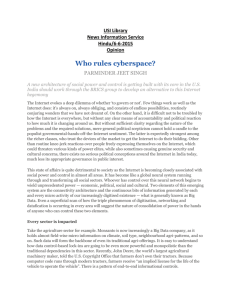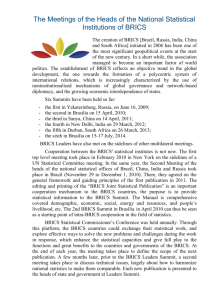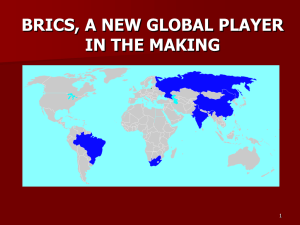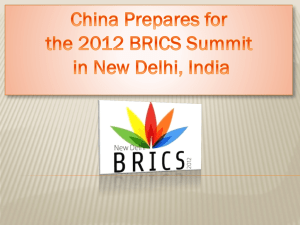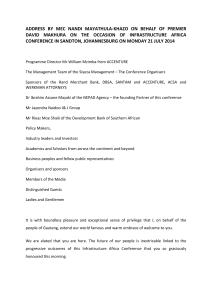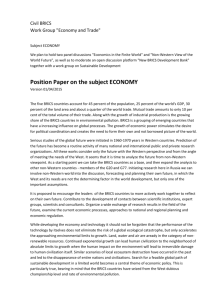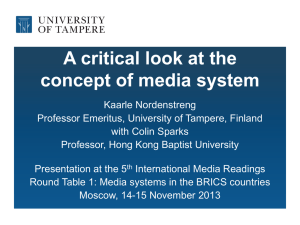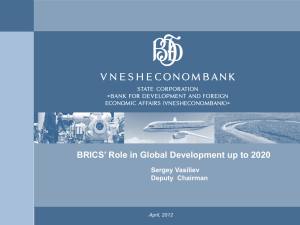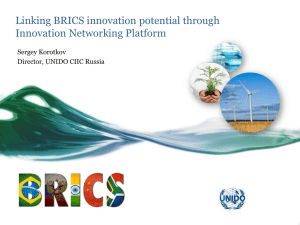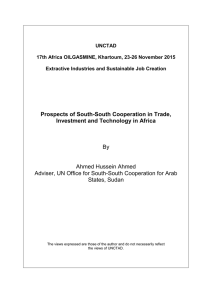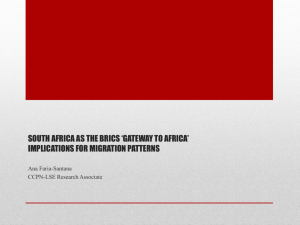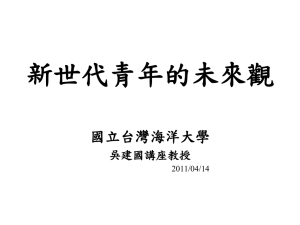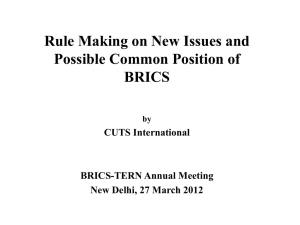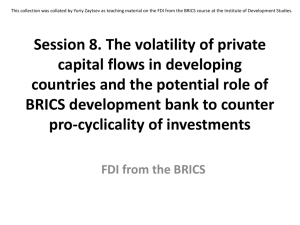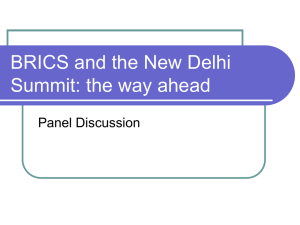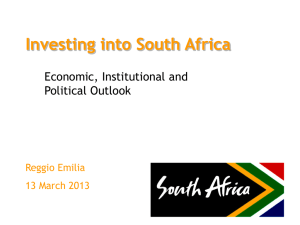India in the BRICS
advertisement
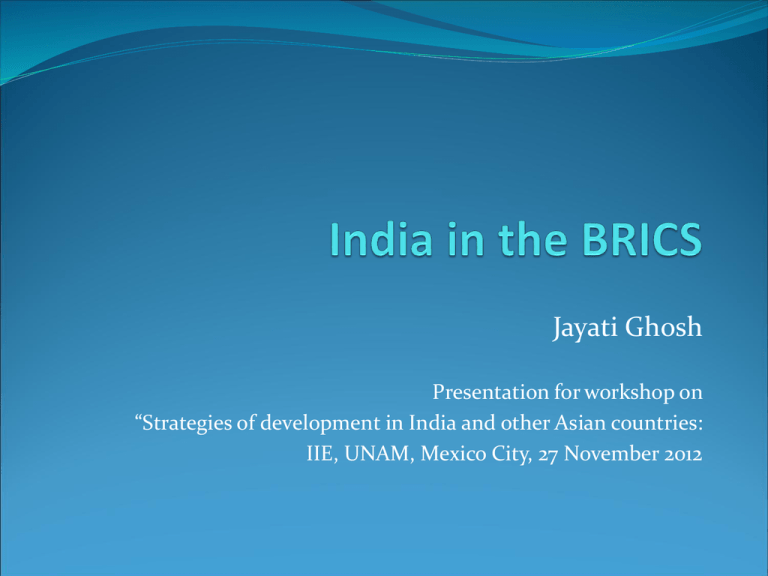
Jayati Ghosh Presentation for workshop on “Strategies of development in India and other Asian countries: IIE, UNAM, Mexico City, 27 November 2012 The idea of the BRIC(S) Investment banker Jim O’Neill of Goldman Sachs first wrote in 2001 about the growth potential of four countries that would overtake G7 in (PPP) size by 2027. Countries with most economic potential for growth based on Size Demography Recent growth rates Embrace of globalisation So China to become most important global exporter of manufactured goods; India exporter of services; Russia and Brazil exporters of raw materials. BRICS as an entity Although geographically separated, economically and politically distinct, with different levels of development and with not such strong economic ties at that time, these countries began to see themselves as a group largely because of foreign investor and media perceptions. Group had its first summit meeting in June 2009 in Yekaterinaburg, Russia. They have now met in Brasilia in 2010, Sanya China in 2011 and New Delhi India in 2012. In 2010 South Africa was included (at the instigation of China). BRICS now cover 3 billion people, with total estimated GDP of nearly $14 trillion and around $4 trillion of foreign exchange reserves. Each country sub-regional leader. Other potential candidates for inclusion: South Korea and Mexico (both OECD members), Indonesia, Turkey, Argentina. Political and economic grouping BRICS is one of several new initiatives of different countries in the world to break out of Northern axis: G12 (G20-G8); IBSA and BASIC (BRICS minus 1) and so on. Trade and investment relations between these countries have grown rapidly after formation of the group. They have recently acted in concert in several international platforms, most recently pledging $75 billion to IMF (conditional on IMF voting reform). Other economic initiatives include agreement to denominate bilateral trade in each other’s currencies, and plans for a development bank. Declarations for shared approach in foreign policy, particularly responses to US and European policies in the Middle East and elsewhere. Learning from one another BRICS Financial Forum 2012 highlighted importance of development banking, which is significant and growing in all BRICS countries except India, which has destroyed its earlier development banking system. Potential for sharing “green” technologies especially in the face of continued IPR protection and resistance to sharing from Northern countries. Potential for “Marshall Plan” type capital flows from surplus to deficit countries (even those outside BRICS) to enable them to withstand impact of coming global recession. Slowdown in US and Europe has already affected exports and GDP growth in BRICS GDP growth % Brazil Russia India China South Africa Industrial production Inflation 2012 2012 Latest Year-on-year Consumer est. quarter Latest data % prices % 1.5 1.6 -3.8 5.3 3.7 2.9 1.9 5.1 5.8 0.1 -0.4 9.4 7.8 9.1 9.6 2.9 2.5 3.2 -0.8 5.3 Unemployment rate % Current account balance (% of GDP) 5.4 5.2 9.8 4.1 25.5 -2.8 +4.5 -4.0 +2.6 -6.3 Internal challenges common to BRICS Other than Brazil, recent growth has been associated with rapidly rising inequality. Even Brazil still has very high inequality despite recent reduction. Inadequate productive employment generation despite recent rapid growth. Inequalities in access to basic public services and utilities. Lack of social protection (despite recent improvement in South Africa and Brazil). Recent growth associated with construction and real estate boom that is now winding down in all countries. This combines with global headwinds to create domestic financial fragilities that can lead to banking crises. South-South interaction – the expectation It used to be believed that that economic interaction between developing countries (South-South integration) would necessarily be more beneficial than North-South links. North-South reproduces the global division of labour that emerged by the mid 20th century, with developing world specializing in primary commodities and labour-intensive (and therefore lower productivity) manufactured goods, while the North keeps the monopoly of high value added production. By contrast, trade and investment links between countries in the Global South were supposed to allow for more diversification because of their more similar stages of development, thus creating more synergies. These perceptions have changed drastically The emergence of East Asian countries (especially China) as giant manufacturing hubs has been driven to a significant extent by North-South trade and investment. The relations between China, India, Brazil and other “emerging” countries with less developed countries has not always been along the predicted lines. Accusations of “new colonialism” now more common – especially in hypocritical North, but also in South. Questions about whether BRICS will feed into this, especially by controlling their own backyards and other weaker developing countries. Concerns Growing trade and investment links of BRICS with poorer developing countries seek to exploit their natural resource base of these countries, siphoning them off in ways that are ecologically damaging, inherently unequal and of little benefit to the local people. Cheaper exports from these semi-industrial countries undermine the competitiveness of local production in the poorer countries, thereby causing further shifts into primary commodity exporting and thereby stunting their development process. So China is said to be dumping its products in economies across the world, and using the resulting foreign exchange surpluses to invest in and provide aid to authoritarian regimes that allow access to natural resources. Similarly Indian corporate investors are said to be engaged largescale land-grab in countries of North Africa and predatory behaviour elsewhere. Reality is more complex Primary exporting countries are better off if there is increased competition among imperialists or traders, since that allows for better terms of such exports. Even China’s relationship with LDCs is not based on colonialstyle control of political power, but more arms-length. New manufacturing hubs with increasing import demand has allowed less developed countries indirect access to the developed world market, while the fast growth of BRICS has resulted in rapidly growing internal markets which these countries stand to gain. This provides an important source of demand stimulus even as developed countries are increasingly mired in financial crisis and economic stagnation. But cross-border interaction is still too driven by corporate interests Many recent South-South trade and investment agreements (and the resulting processes) have been similar in unfortunate ways to North-South ones, not just in terms of the protection they afford to corporate investors but even in guarding intellectual property rights! Land grab and other tendencies by Chinese and Indian companies. To the extent that companies everywhere have similar interests (the pursuit of their own profits) it is not surprising that older North-South patterns are replicated. Change of direction is required both within and outside BRICS Potential for positive change is he but needs to be more people-oriented, not profit-determined. Patterns of trade and investment flows should be altered to emphasise the creation of decent employment in all these countries. Immense possibilities for technology sharing and coordinating technology development, in a world where intellectual property rights still largely controlled by Northern multinational companies have emerged as a major constraint on development Gracias por su atencion! Thanks for your attention!


